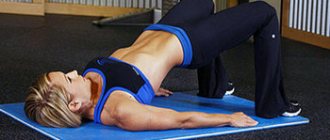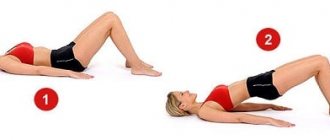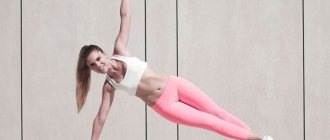What muscles work when performing the Glute Bridge exercise?
What muscles work during this exercise? Primarily, the gluteus maximus and quadriceps femoris muscles . As you know, they are among the largest muscles in our body, and in the process of work they burn a large number of calories. This means that weight loss occurs faster.
Main muscles involved when performing the Glute Bridge
the gluteus medius and minimus muscles , the muscles of the back and the lower abdominal area are actively involved in performing the bridge . Thanks to this, with regular and correct performance of the bridge, a strong muscle corset is formed, and the body as a whole becomes much stronger. This is another reason to start doing glute bridges.
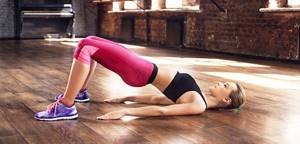
Glute bridge helps burn calories
Do a lying bridge every day - and this is what will happen
Amazing and effective exercise!
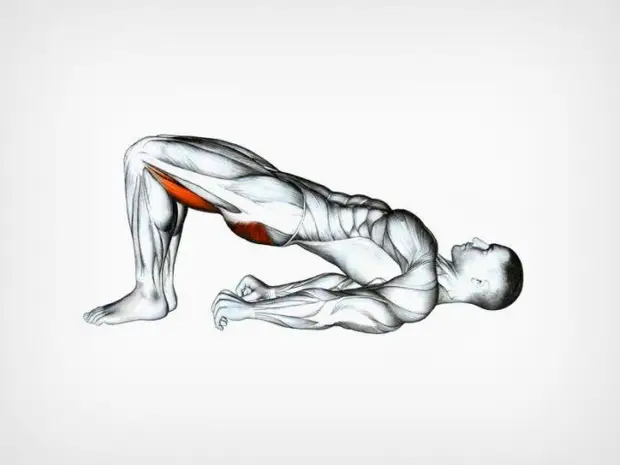
Perhaps every girl dreams of becoming the owner of a beautiful butt. However, nothing comes easy; beautiful buttocks are the result of constant training, especially in our current “sedentary” society, which uses the buttocks exclusively for sitting. By the way, the gluteal muscles, like the rest of the muscle groups in our body, need strengthening and movement, which the gluteal muscles are provided by an exercise called “lying pelvic lift,” “lying bridge,” or “butt bridge.” You may have heard other names for this exercise - this is not so important. The really important thing is that correctly performing a bridge while lying down will allow you to properly warm up the gluteal muscles. However, one problem is that not everyone realizes what pelvic lifts can do for their body. And this: 1. Lifting the pelvis while lying down will drive away back pain. Weakened by lack of activity, the gluteal muscles are a sure way to back pain. When the erector spinae and hamstring muscles take over the work that the gluteal muscles should do, what is called gluteal amnesia occurs. This leads to the fact that the load that should be taken by the hips is transferred to the lower back, which is not designed for this purpose.
As a result of this, back pain appears.
Do a glute bridge every day to awaken your gluteal muscles and pelvic area. This will ensure your body remembers to use your glutes for movement rather than your lower back. 2. Lying pelvic raises will make knee pain leave you. One of the main causes of knee pain is insufficient control of the femur, i.e. it may slide forward slightly, evert out, or move closer to the center of the body. Such frequent movements lead to knee pain. The gluteal muscles play an important role in controlling the femur at the hip joint, which affects the movement of other bones connected by the knee joint. A butt bridge (especially the one-leg version) will “teach” the femur to be in the correct position and relieve knee pain. 3. You will become taller Working out at the gym is great, but if you spend the rest of the day shrunken, an hour of training will not return you to ideal posture. Active and strong gluteal muscles and the pelvic bowl help to sit correctly, i.e. muscles located under and above the pelvis, such as the core muscles, if these muscles are weak, take the blow, which leads to incorrect posture. 4. Beautiful butt It is very difficult to pass by a beautiful butt without paying attention to it. So it was and so it will be. There is no point in describing this point - you already know everything yourself. Just do a butt bridge every day - and don’t be surprised that your significant other will start grabbing your butt more often. 5. The lying bridge will solve your problems with jeans As a rule, women often face a huge problem - sometimes they just can’t fit into their favorite jeans. The solution to this problem is simple and ingenious - an ideal butt that will look perfect in almost any jeans. What is needed for this? Perform lying pelvic lifts every day! 6. You can set personal records in deadlifts and squats with a barbell. Deadlifts and squats require activity and strength of the gluteal muscles.
Weak and inactive gluteal muscles are unable to create sufficient tension in the thigh - this is precisely the problem that many exercisers face. The reason is the lack of effective interaction between the hips and the core. One of the benefits of performing a glute bridge is that there are a bunch of variations of this exercise aimed at both activating and strengthening the gluteal muscles. Therefore, lying pelvic raises will help you achieve greater success in deadlifts and squats with a barbell. In general, by performing a butt bridge every day, you can get rid of both annoying back and knee pain and train your muscles, making other exercises in the gym and everyday life much easier for you! Source
How to do a glute bridge correctly?
The technique for doing it is quite simple. You can begin to master the exercise by working at home with your own weight, and gradually move on to using weights.
When using your own weight, the exercise is easier to perform on the floor. The feet, slightly turned to the sides, are fixed on the floor, the knees are bent at an obtuse angle (about 100 degrees), the shoulder blades are pressed to the mat, the arms are laid parallel to the body.
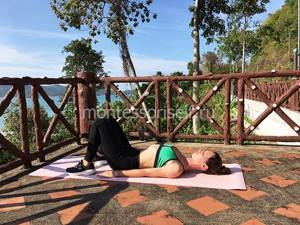
Step 1 - Glute Bridge
As you exhale, lift your pelvis upward until your body forms a straight line, which is held for a couple of seconds. As you exhale, the pelvis is released and immediately rises again.
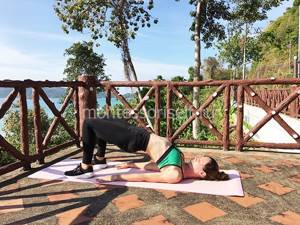
Step 2 - Glute Bridge
When performing this exercise for the buttocks, take into account this nuance: at the peak of the “bridge” you need to contract the buttocks as much as possible, thereby freeing your back and abs from excess load. It’s ideal if you feel your gluteal muscles “burning.” Tighten them for two to four counts, then smoothly lower your pelvis. When completing the exercise, you can extend the time you hold the “bridge” and slightly spring your buttocks to better work them out.

Technique for performing a gluteal bridge
You will be able to do better squat exercises
Squats are often thought of as leg exercises. But ask any experienced athlete, and he will tell you that these exercises actually pump up the muscles of the thighs and buttocks. In order to perform squats safely and effectively, it is important to keep these muscles active and strong. Undeveloped and weak gluteal muscles create poor tension for the thigh muscles. This is one of the most common problems among beginners. Poorly developed glutes reduce the depth of your squat, so your hips and joints cannot work together effectively.

These are prejudices: why relationships on dating sites are no worse than real ones
With chicken, seafood: several options for salads with pineapples
In Denmark they jump from chairs: New Year's traditions from around the world
There are many variations on how you can perform the bridge exercise. They are all programmed to activate or strengthen your butt muscles, depending on what you choose. Doing these exercises every day will allow your glutes to catch up with your hamstrings and hips, improving your squat performance.
Glute bridge with leg raise (correct technique)
The single leg glute bridge is a slightly more complicated version of the exercise and involves more muscles. While performing it, fully straighten the raised leg, while pulling the toe towards the shin. Make this leg an extension of the line of your stomach and chest. Feel the tension in the muscles of your legs, buttocks and abs, this is the desired effect! It is enough to do several such repetitions, after which you can change legs.
Step 1 - stretch out the body and arms on the mat. We bend our legs at the knees.

Glute Bridge with Leg Raise (Step 1)
Step 1 - lift the body onto the shoulder blades and extend one leg, trying to make the body and leg form one line. We try to hold the pose for 10-20 seconds. Lower the body and leg.

Glute Bridge with Leg Raise (Step 2)
Step 3 - raise the other leg, and try to hold it for 10-20 seconds.

Glute Bridge with Leg Raise (Step 3)
See how to do a glute bridge with your left leg raised:
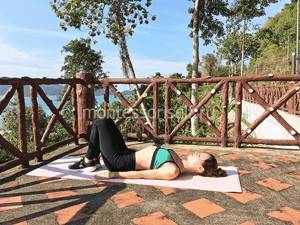
Glute bridge with left leg raise
See how to do a glute bridge with right leg lift:
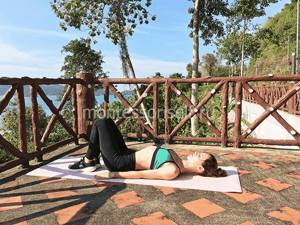
Glute bridge with right leg raise
Execution technique
The correct technique for performing the classic version of the gluteal bridge:
- Starting position: lie on your back, bend your knees, stretch your arms along your sides.
- Place your feet shoulder-width apart and press firmly to the floor.
- Relax your spine and maintain as neutral a position as possible.
- Inhaling, raise your hips, strongly squeezing your buttocks and resting on your heels. Form a straight line from knees to shoulders.
- Hold your body up (1-2 seconds).
- Lower the pelvis smoothly, without sudden movements.
- It is important to monitor the range of motion and not relax the muscles.
- Do 3-4 sets of 15-20 repetitions, without changing the speed and amplitude of the movement.
A correct and strict approach to technique guarantees lasting results and significantly reduces the risk of back injury. The options for the gluteal bridge are very diverse: with your own weight, weights, various exercise machines, and so on. In each case, different parts of the body are involved.
You can perform the basic version of the exercise for the buttocks both at home and in the gym.

Glute bridge with barbell
This exercise can be used as a warm-up before lifting weights. You can use a barbell or one pancake as a weighting agent. The gluteal bridge with a barbell is performed on a bench where the upper half of the body is fixed. The feet are fixed on the floor, the legs are bent at an obtuse angle. The weight is placed on the lower half of the abdomen. In the process of raising and lowering the pelvis, you need to hold the load with your hands.
The effectiveness of this exercise depends on the correctness of its execution, the number of repetitions and approaches, as well as the weight of the weight. But at the beginning of training, it is better to increase the number of repetitions than to focus on heavy loads. Only after having mastered the exercise technique perfectly can you begin to work with weights.
